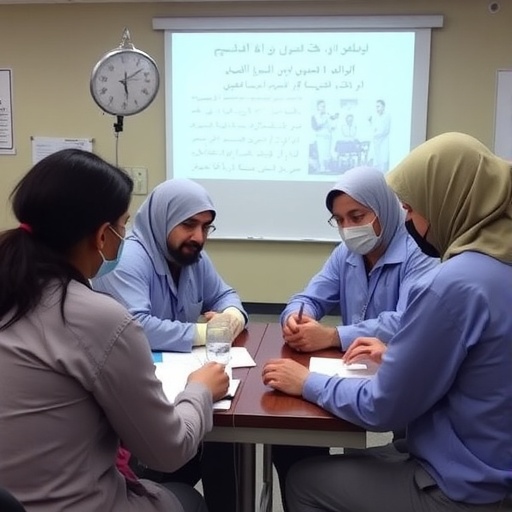In recent years, the Iranian healthcare system has faced unprecedented challenges, particularly concerning its health workforce. A novel scoping review conducted by Khodayari-Zarnaq et al. shines a spotlight on these critical issues, which are often overlooked in discussions about healthcare reform. This comprehensive investigation delves deep into the structural and systemic inequalities that plague the country’s health services, providing invaluable insights for policymakers, healthcare professionals, and scholars alike.
The study begins with a contextual overview of Iran’s healthcare landscape, which has undergone significant changes over the past few decades. The nation has made considerable advancements in improving health indicators, yet the human resources aspect remains a perennial hurdle. The review identifies critical gaps in workforce distribution, qualifications, and professionalism, emphasizing the need for effective strategies to alleviate these pressures.
One primary concern highlighted in the review pertains to the maldistribution of health workers across urban and rural areas. Less populated regions are notoriously underserved, suffering from a scarcity of medical professionals, while urban centers are often inundated with healthcare practitioners. This uneven landscape not only limits access to care for millions but also exacerbates health disparities, leading to poorer outcomes for vulnerable populations.
Furthermore, the authors point out the challenges of recruitment and retention of qualified healthcare personnel in Iran. Factors such as bureaucratic inefficiencies, inadequate financial incentives, and the lack of professional development opportunities contribute to an environment that discourages health workers from serving in critical areas. This issue is particularly prominent among specialized medical practitioners who are more likely to migrate abroad for better opportunities.
Moreover, the scoping review brings forth a critical examination of the existing educational frameworks for preparing health professionals. The study delves into the inadequacies of current training programs, which often do not align with the real-world demands faced by practitioners within the healthcare system. There is a pressing need for reforms that address curriculum development, mentorship opportunities, and clinical exposure to ensure that health workers are equipped with the requisite competencies.
The growing influence of technology in healthcare is another focal point of this research. With the increasing integration of telemedicine and digital health platforms, there is a dual-edged sword effect. While technology has the potential to enhance accessibility and efficiency, it also raises concerns about the need for adequate training and support for health workers. The absence of comprehensive tech training can lead to disparities in care delivery, particularly for older practitioners who may be less familiar with new technologies.
In addition to educational inconsistencies, the review also discusses the societal perception of healthcare roles in Iran. Cultural expectations and stigmas associated with certain professions can deter individuals from pursuing careers in healthcare, particularly in nursing and allied health fields. By addressing these societal misconceptions, stakeholders can foster a more favorable environment for recruitment into the healthcare workforce.
The study further emphasizes the importance of policy involvement in tackling these challenges. Policymakers must be aware of the multifaceted nature of healthcare workforce issues and implement holistic strategies that address not only recruitment and retention but also the overall work environment. This includes better working conditions, support systems, and recognition programs aimed at valuing the contributions of health workers.
As Iran continues to navigate the complexities of its healthcare system, the importance of continuous research cannot be understated. The findings from this scoping review serve as a clarion call for further investigations into specific workforce issues, such as mental health among healthcare workers and the impact of workload on service delivery. By prioritizing research, Iran can develop more effective, evidence-based strategies to bolster its health workforce.
In conclusion, the scoping review presented by Khodayari-Zarnaq and colleagues highlights the critical challenges facing the Iranian health workforce and serves as a crucial resource for guiding future interventions. Stakeholders in the healthcare system must come together to devise comprehensive strategies that address the systemic issues outlined in the study, thereby paving the way for a healthier future for all Iranians.
The review concludes by urging collaboration between various sectors, including government, academia, and the private sector, to transform the health workforce landscape. Uniting these forces is key to overcoming existing barriers and creating a sustainable and robust healthcare system that can adeptly respond to the needs of the population.
As the challenges mount, so must the collective efforts of all involved in healthcare. The commitment to improving workforce conditions and capabilities is vital for ensuring not only the health of the present generation but also for future sustainability.
Subject of Research: Challenges for health workforce in the Iranian healthcare system
Article Title: Challenges for health workforce in the Iranian healthcare system: a scoping review
Article References:
Khodayari-Zarnaq, R., Ghasemyani, S., Mobasseri, K. et al. Challenges for health workforce in the Iranian healthcare system: a scoping review.
BMC Health Serv Res 25, 1361 (2025). https://doi.org/10.1186/s12913-025-13167-w
Image Credits: AI Generated
DOI: 10.1186/s12913-025-13167-w
Keywords: health workforce, Iranian healthcare system, scoping review, health disparities, healthcare policy, professional development, recruitment, retention, technology in healthcare, healthcare education




